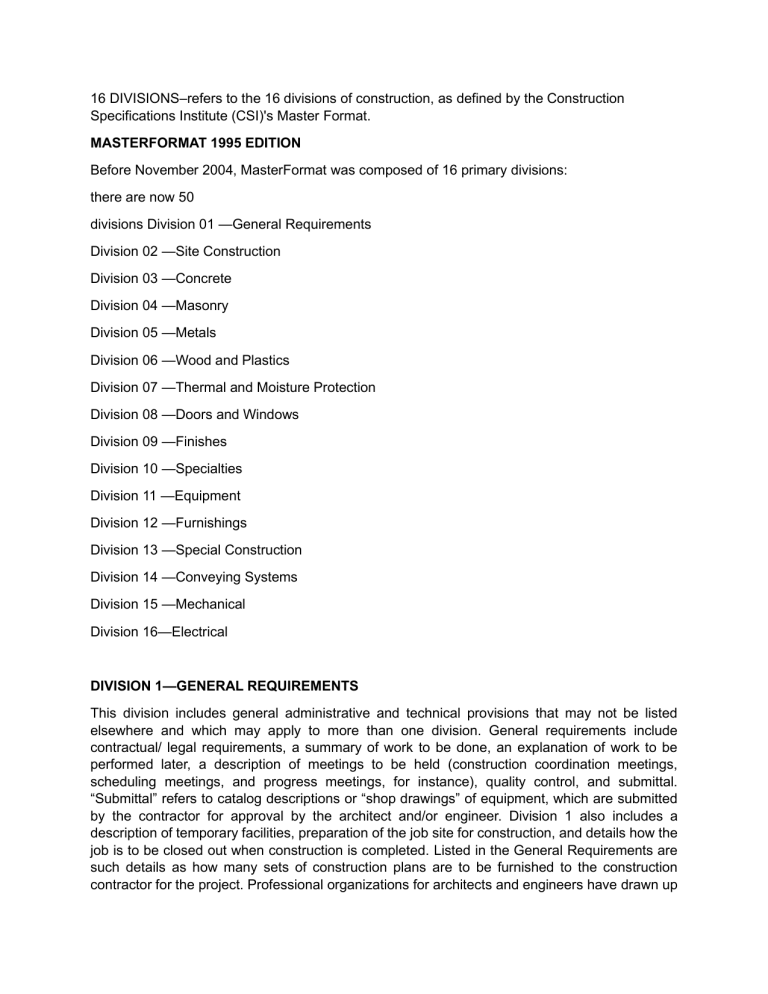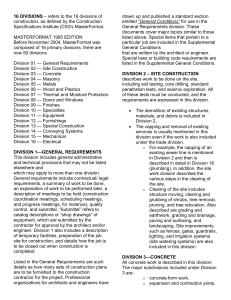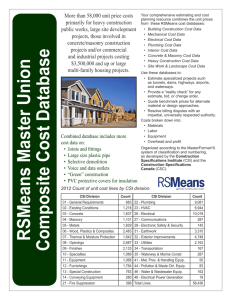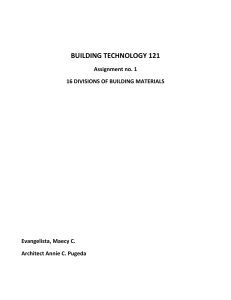
16 DIVISIONS–refers to the 16 divisions of construction, as defined by the Construction Specifications Institute (CSI)'s Master Format. MASTERFORMAT 1995 EDITION Before November 2004, MasterFormat was composed of 16 primary divisions: there are now 50 divisions Division 01 —General Requirements Division 02 —Site Construction Division 03 —Concrete Division 04 —Masonry Division 05 —Metals Division 06 —Wood and Plastics Division 07 —Thermal and Moisture Protection Division 08 —Doors and Windows Division 09 —Finishes Division 10 —Specialties Division 11 —Equipment Division 12 —Furnishings Division 13 —Special Construction Division 14 —Conveying Systems Division 15 —Mechanical Division 16—Electrical DIVISION 1—GENERAL REQUIREMENTS This division includes general administrative and technical provisions that may not be listed elsewhere and which may apply to more than one division. General requirements include contractual/ legal requirements, a summary of work to be done, an explanation of work to be performed later, a description of meetings to be held (construction coordination meetings, scheduling meetings, and progress meetings, for instance), quality control, and submittal. “Submittal” refers to catalog descriptions or “shop drawings” of equipment, which are submitted by the contractor for approval by the architect and/or engineer. Division 1 also includes a description of temporary facilities, preparation of the job site for construction, and details how the job is to be closed out when construction is completed. Listed in the General Requirements are such details as how many sets of construction plans are to be furnished to the construction contractor for the project. Professional organizations for architects and engineers have drawn up and published a standard section entitled “General Conditions” for use in the General Requirements division. These documents cover major topics similar to those listed above. Special items that pertain to a particular job are included in the Supplemental General Conditions that are written by the architect or engineer. Special laws or building code requirements are listed in the Supplemental General Conditions. DIVISION 2–SITE CONSTRUCTION describes work to be done on the site, including soil testing, core drilling, standard penetration tests, and seismic exploration. All of these tests must be conducted, and the requirements are expressed in this division. The demolition of existing structures, materials, and debris is included in Division 2. The capping and removal of existing services is usually mentioned in this division even if the work is also included under the trade division. • • For example, the capping of an existing sewer line is mentioned in Division 2 and then is described in detail in Division 16 (plumbing). In addition, the site work division describes the various steps in the clearing of the site. Clearing of the site includes structure moving, clearing and grubbing of shrubs, tree removal, pruning, and tree relocation. Also described are grading and earthwork, grading and drainage, paving and surfacing, and landscaping. Site improvements such as fences, gates, guardrails, lighting, and irrigation systems (site watering systems) are also included in this division. DIVISION 3—CONCRETE All concrete work is described in this division. The major subdivisions included under Division 3 are: • • • • • concrete form work, expansion and contraction joints, Cast -in-place concrete; Specially placed concrete, And recast concrete DIVISION 4—MASONRY Division 4 of the specifications deals with brick stone, fire brick, glass brick, clay backing tile, and ceramic veneer. Related topics such as joint reinforcement, mortar, anchor and tie systems, masonry joints, control joints and masonry accessories are also included. DIVISION 5—METALS The metals used in the building are specified under Division 5. If the building has a steel structure, the steel members are specified in this section. Metal roof decking, metal floor decking, and permanent metal forms are described in this section. Metal fabrication such as stairs, handrails, railings, gratings, castings, and lintels are included in this division. In some cases, ornamental metals are used for these fabrications and are described in detail in this section. DIVISION 6—WOOD AND PLASTICS Materials such as rough carpentry (framing), heavy timber construction, prefabricated structural wood, finished carpentry, and architectural woodwork (cabinets and built-in-woodwork) are described in this division. Plastics are used in many ways in modern construction. This section of the specifications is devoted to such items as joists, studs, columns, beams, hangers, connecting devices, and other miscellaneous plastics items not specially identified under the headings. DIVISION 7—THERMAL AND MOISTURE PROTECTION Division 7 contains written descriptions of roofing materials, waterproofing materials, flashing and sheet metal trim, insulation, roof accessories and sealants. DIVISION 8—DOORS AND WINDOWS Metal doors and frames wood and plastics doors, entrances and storefronts, metal windows, special windows, wood and plastics windows, hardware and specialties, and glazing are the main areas of concern in Division 8. DIVISION 9—FINISHES Lath and plaster, gypsum wallboard, terrazzo, acoustical treatment, ceiling suspension system, wood flooring finishes, carpeting, special flooring, floor treatment, painting, special coatings, and wall covering are found in this division of the specifications. DIVISION 10—SPECIALTIES Division 10 of the specifications is a catch-all section. If items required for the construction do not fall under the other divisions of the specifications. They are usually found in Division 10, Typical items in this division are chalkboards and tackboards, louvers and vents, grilles and screens, pest control, fireplaces, flagpoles, lockers, storage shelving, directional signage and sun control devices. DIVISION 11—EQUIPMENT Division 121 lists equipment which is normally furnished and installed by the general contractor as a part of the construction of the building. Equipment described in this division includes maintenance equipment, bank and vault equipment, food service equipment, laundry equipment, library equipment, medical equipment, waste handling equipment and loading dock equipment. DIVISION 12—FURNISHINGS Major headings in this division are artworks, window treatment, fabrics, furniture, rugs and mats, and furnishing accessories. DIVISION 13—SPECIAL CONSTRUCTION The description and necessary information for constructing special areas are given in this division. Special construction areas include clean rooms, operating rooms in the hospitals, incinerators, instrumentation rooms, nuclear reactors, radiation treatment rooms, sound and vibration rooms, vaults and swimming pool spaces. DIVISION 14—CONVEYING SYSTEM Dumbwaiters, elevators, hoists and cranes, lifts, material handling systems, moving stairs and walks, and pneumatic tube systems are typical items described in Division 14. DIVISION 15—MECHANICAL/PLUMBING Division 15 covers information on air conditioning, ventilating and heating in a building. The mechanical division of the specifications generally has major sections consisting of general provisions (general descriptions of the work, procedures, etc.) basic materials and methods, equipment, air distribution, piping, installation, controls, and instrumentation. Note: Plumbing specifications are also included in the standard mechanical specification division: however, many engineer now write plumbing specification as a separate division. With plumbing as Division 16, electrical becomes Division 17. DIVISION 16—ELWECTRICAL The electrical division usually consists of general provisions, basic materials and methods, power generation, power transmission, power service and distribution, lighting, special systems, communications, controls and instrumentation.



